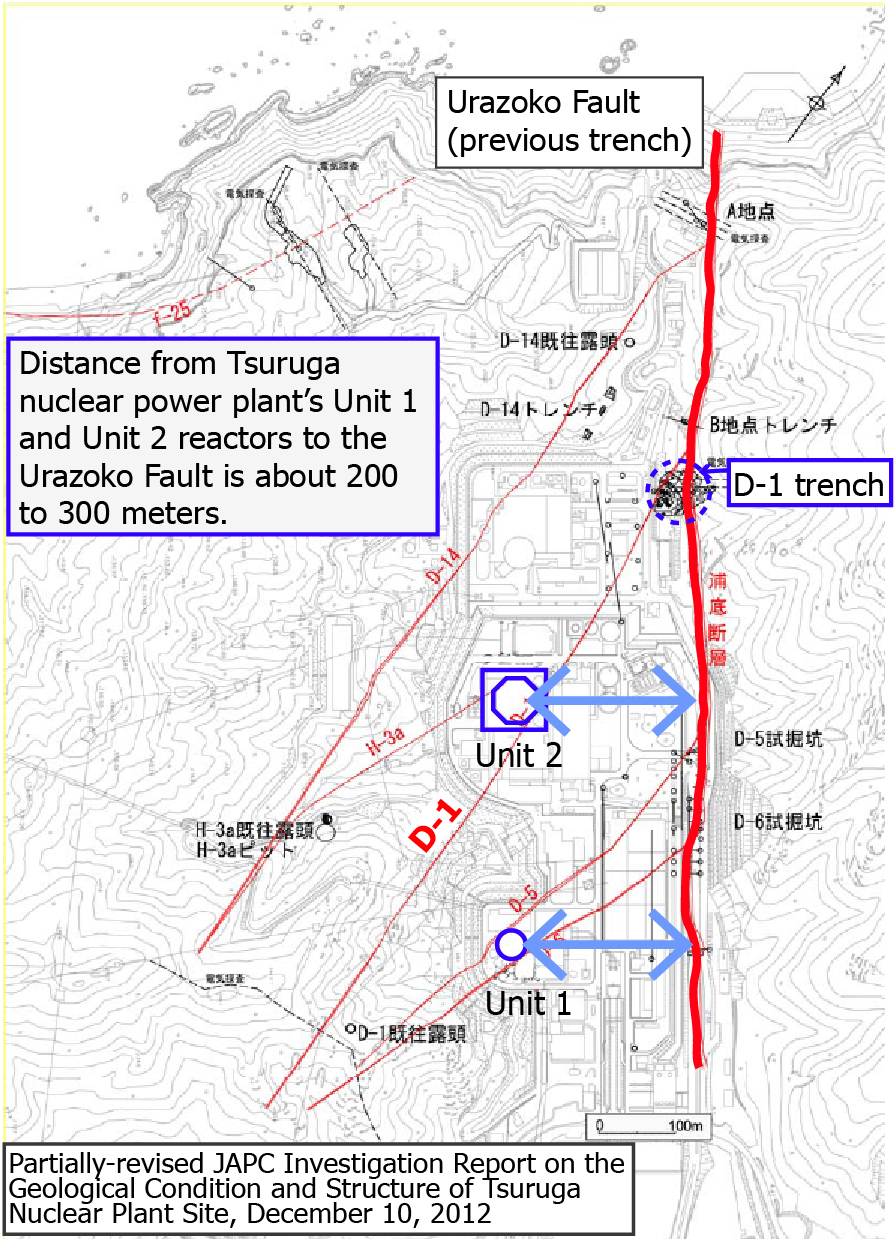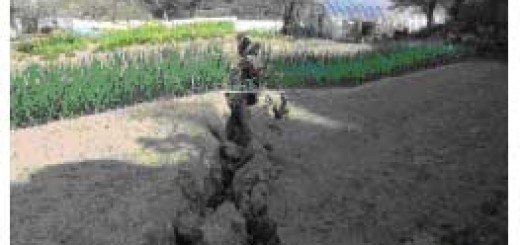Fault directly beneath Tsuruga Unit 2 reactor officially recognized as active Nuke Info Tokyo No. 155
-Nuclear Regulation Authority’s responsibility is grave-
 |
|
Photo
Urazoko Fault trench (by Masako Sawai, April 2008) |
 |
| Figure 1. Locations of Unit 1 and Unit 2 reactor buildings and Urazoko Fault (partially-revised NRA map) |
On May 22, 2013, the Nuclear Regulation Authority (NRA) approved a report by a panel of experts investigating the fracture zones at Japan Atomic Power Co.’s (JAPC) Tsuruga Nuclear Power Station stating that Unit 2 is sitting above an “active fault that should be taken into consideration in Seismic Design.”(1)(2) The Seismic Design guidelines for nuclear power plants, formulated in September 2006, define an active fault that should be taken into consideration in Seismic Design as a fault that has undeniably moved in or after the Late Pleistocene (120,000-130,000 years ago). The NRA’s recognition of the active fault has increased the likelihood that the reactor will never be restarted and will eventually be decommissioned.
Changes in the evaluation of the Urazoko Fault
An active fault, named the Urazoko Fault, runs northwest to southeast through the Tsuruga Nuclear Power Station site about 200 to 300 meters from the reactor buildings (Figure 1). JAPC consistently claimed that this fault was not active when the company applied for official permission to construct Unit 1 (October, 1965), Unit 2 (March, 1979) and Units 3 and 4 (March 2004). The government approved this assessment each time.
In February 2005, however, the Nuclear and Industrial Safety Agency (NISA) ordered JAPC to re-investigate the Urazoko Fault as an additional requirement for approving construction of Units 3 and 4. The company therefore carried out a large-scale investigation by digging trenches. In its report issued in March 2008, JAPC acknowledged for the first time that the Urazoko Fault was active. Furthermore, it was discovered that this fault had moved repeatedly since the Late Pleistocene, the latest movement occurring within the past 4,000 years. As a result, it became scientifically certain that the Urazaoko Fault, which exists in close proximity to the reactor buildings, is a very active first-class fault (see photo page 1). Regarding the number of fractural zones (faults) that exist in the plant’s premises, JAPC repeatedly asserted that these faults would not move together with the Urazoko Fault, based on the results of its own computer simulations.
D-1 fracture zone is an active fault
The first thing revealed by the panel’s investigation was that the D-1 fracture zone, a branched fault (secondary fault) running beside the Urazoko Fault (main fault), passes underneath the Unit 2 reactor building. Moreover, two other faults, G and K, were discovered at the location of the “D-1 trench,” indicated in the figure. This discovery served as the main reason why the faults underneath Unit 2 were officially recognized as active. The existence of the two faults remained totally unknown until this time.
The panel says it is highly possible that these newly-discovered faults are part of the D-1 fracture zone, because the K fault appears to have moved simultaneously with the Urazoko Fault, or after the Urazoko Fault had moved, and it is“an active fault that should be taken into consideration in the Seismic Design.” In addition, the K and G faults are both located very close to the extension of the D-1 fracture zone, and the line of strike and inclination of their strata are quite similar to the D-1 fracture zone. Evaluating these factors comprehensively, the panel has concluded that the D-1 fracture zone running beneath the Unit 2 reactor building is an active fault that should be taken into consideration in Seismic Design, and predicts that it will move together with the nearby Urazoko Fault. The panel warns that the important facilities above the fault may be damaged if this happens.
What is the mission of the NRA?
The government has repeatedly insisted that it will “not build (nuclear power plants) above active faults.” It has explained that it had “avoided active faults based on the results of various types of investigations, such as literature searches and air photos, and had confirmed the absence of active faults by conducting geographical investigations and drilling explorations.”(3) However, in the case of Tsuruga Unit 2, an active fault that has moved recently runs 200 to 300 meters from the reactor core. Moreover, fracture zones of the same structure as the active fault run immediately beneath the reactor. This shows the clear and grave fact that the government’s safety examination was faulty or very deficient. The NRA holds a great responsibility for this. The Japanese nuclear watchdog should acknowledge that the safety investigation was defective and cancel the construction permit of the Tsuruga nuclear power plant (permission for alteration in the case of Unit 2).
In the eye of the law, it seems possible for the NRA to refer to its right to examine and cancel the reactor construction permit under its own authority when the safety requirements are not met, even though there are no provisions to this effect in the Nuclear Reactor Regulation Law. With regard to the Tsuruga nuclear plant, it has become clear that the faults that should be taken into consideration in Seismic Design exist directly underneath the reactor buildings and the location of the reactor itself is questionable from the viewpoint of preventing nuclear accidents. Having approved construction of the Tsuruga nuclear plant in the first place, it is unconscionable of the NRA to now demand that JAPC apply to decommission the nuclear reactor. What the NRA should do is first make an admission of the previous regulatory authority’s deficiencies by cancelling the reactor construction permit.
New nuclear power regulations cannot be established without seriously reflecting on the traditional safety investigation procedures and the limitations and problems of the previous probes. The NRA should fulfill its responsibility and mission in accordance with the conclusion the NRA itself has reached.
(Masako Sawai, CNIC)
(1) “Evaluation of fracture zones in the site of the Japan Atomic Power Co.’s Tsuruga Power Plant” Nuclear Regulatory Agency, www.nsr.go.jp/committee/kisei/data/0007_01.pdf
“Evaluation of the fracture zones on the site of the Japan Atomic Power Co.’s Tsuruga Power Plant”
www.nsr.go.jp/committee/kisei/data/0007_02.pdf
(2) For more information on the panel of experts and the investigations into the fracture zones, see “How the investigation of active faults will be conducted” by Chihiro Kamisawa, Citizens’ Nuclear Information Center Newsletter No.464. (Japanese)
(3) Seismic Safety Design for Nuclear Power Plants, Resources and Energy Agency of the Ministry of Trade and Industry, October 1999

